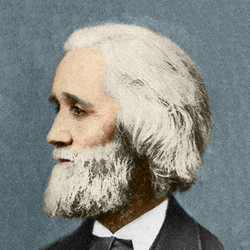Christopher Latham Sholes
- Birthdate
- 1819/02/14
- Birthplace
- Mooresburg, Pennsylvania
- Death date
- 1890/02/17
- Fields of study
- Mechanical Engineering, Journalism, Publishing
Biography
Christopher Latham Sholes was an American inventor that invented the QWERTY keyboard and one of the earliest typewriters.[1]
Sholes was born February 14th, 1819, near Mooresburg, Pennsylvania. On his mother's side, his bloodline can be traced back to notable pilgrims John and Priscilla Alden. His paternal grandfather had commanded a gunboat during the Revolutionary War and his father Orrin served in the War of 1812 and was rewarded for his service with a bed of land in Pennsylvania. In 1823, when Sholes was four, Orrin moved his family to Danville Pennsylvania to apprentice his four sons into becoming printers. [2]
In 1833, Sholes completed his schooling to become a printers apprentice in 1833, and in 1837 he moved to the new territory of Wisconsin to work for his elder brothers newspaper publication in Green Bay. [3] After working as an apprentice, he moved to Southport, Wisconsin and founded the Southport Telegraph, a weekly newspaper. Southport was a new town on Lake Michigan's shoreline south of Madison where Sholes served as the owner and publisher of the Telegraph. Settling into Southport, he married Mary Jane MeKinney in 1840, living with his family in the town until 1857.[4]
In addition to publishing, Sholes also played a key role in early Wisconsin politics. Still young, he helped to organize the free Soil and Republican parties in Wisconsin and served several terms in the state senate and assembly. His most memorable legislative accomplishment may have been leading the successful campaign to outlaw the death penalty in Wisconsin in 1853. [5]
Throughout his life, Sholes had already shown incredible feats of intuition, which inevitably led him to take another position as the editor for the Wisconsin Enquirer in Madison. Afterwards in 1860 he choose to instead take another editor position in the Milwaukee News. However, he again dropped this position in favor of becoming a collector for the port of Milwaukee, an appointment given to him by Abraham Lincoln. [6]
Sholes' true passion had laid in being an inventor. With a comfortable, less demanding position as a collector, Sholes had the opportunity in his free time to develop publication machinery. In 1867, while perfecting a page numbering device in Charles F. Kleinsteuber's machine shop in Milwaukeee, Sholes met Carlos Glidden who encouraged him to develop a mechanical writing machine. A few months later, an article titled the "Type Writing Machine" in Scientific American inspired Sholes to pursue this suggestion. With the aid of machinists Matthias Schwalbach and inventor Samuel Soule, they aimed to produce a functioning model by the end of the year. [7]
An improvement on early typewriters, Sholes' success was attributed to the superior mechanical design of his model. Compared to its predecessors, many early model typewriters that were prone to jamming. To fix this problem, Sholes obtained a list of the most common letters used in the English language, and rearranged the keyboard from an alphabetic arrangement to one in which the most common pairs of letters were spread fairly apart. Sholes' arrangement increased the time it took for the typists to hit the keys for common two-letter combinations; enough to ensure that each bar had time to fall back out of the way before the next one came. [8]
James Densmore, an oil man who had heard about their attempts funded tne project and Sholes and Glidden (Soule dropped out after failing in the first attempts) produced more than 30 working models before developing a model that the Remington and Son arms factory was able to produce. The first typewriter model went into production in 1874. [9]
Sales of the 1874 models were not widespread. In 1878, Remington produced a second version, replacing the Shole model, but it only sold 5,000 units by 1886. Sholes died after a long battle with tuberculous in 1890, before he was able to see the success of his machine, and suffered from depression as he perceived his product to be a failure. [10]
References
- ↑ http://www.encyclopedia.com/topic/Christopher_Latham_Sholes.aspx
- ↑ http://www.encyclopedia.com/topic/Christopher_Latham_Sholes.aspx
- ↑ http://www.britannica.com/biography/Christopher-Latham-Sholes
- ↑ http://www.encyclopedia.com/topic/Christopher_Latham_Sholes.aspx
- ↑ http://www.wisconsinhistory.org/Content.aspx?dsNav=Ny:True,Ro:0,N:4294963828-4294963805&dsNavOnly=Ntk:All%7c%7c3%7c%2c&dsRecordDetails=R:CS2697&dsDimensionSearch=D:Christopher+Latham+Sholes,Dxm:All,Dxp:3&dsCompoundDimensionSearch=D:Christopher+Latham+Sholes,Dxm:All,Dxp:3
- ↑ http://www.britannica.com/biography/Christopher-Latham-Sholes
- ↑ http://www.wisconsinhistory.org/Content.aspx?dsNav=Ny:True,Ro:0,N:4294963828-4294963805&dsNavOnly=Ntk:All%7c%7c3%7c%2c&dsRecordDetails=R:CS2697&dsDimensionSearch=D:Christopher+Latham+Sholes,Dxm:All,Dxp:3&dsCompoundDimensionSearch=D:Christopher+Latham+Sholes,Dxm:All,Dxp:3
- ↑ http://www.mit.edu/~jcb/Dvorak/history.html
- ↑ http://www.typewritermuseum.org/history/inventors_sholes.html
- ↑ http://www.wisconsinhistory.org/Content.aspx?dsNav=Ny:True,Ro:0,N:4294963828-4294963805&dsNavOnly=Ntk:All%7c%7c3%7c%2c&dsRecordDetails=R:CS2697&dsDimensionSearch=D:Christopher+Latham+Sholes,Dxm:All,Dxp:3&dsCompoundDimensionSearch=D:Christopher+Latham+Sholes,Dxm:All,Dxp:3
